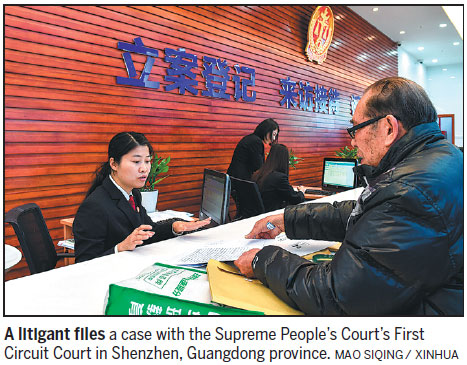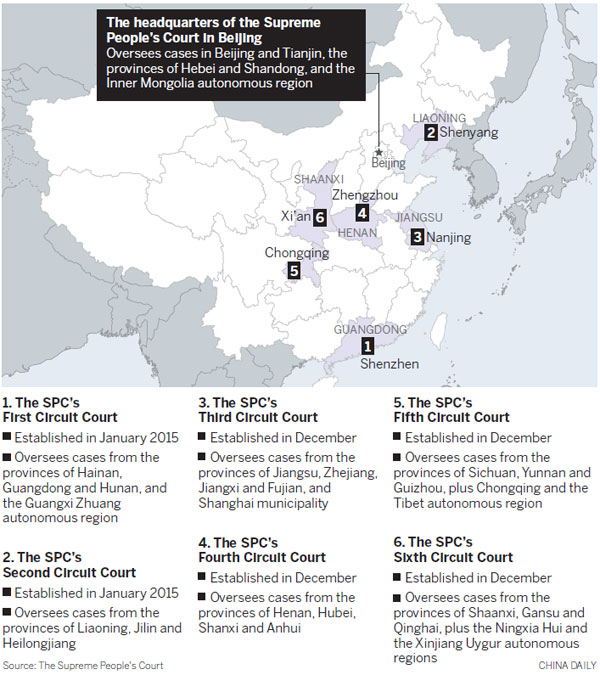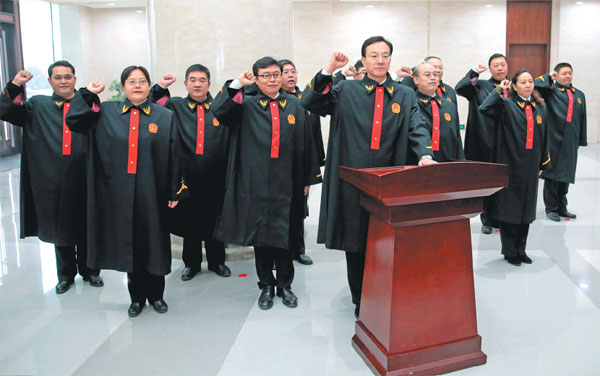Circuit courts bring convenience and speed
For many years, Huang Sizhou, a lawyer in Shenzhen, in the southern province of Guangdong, frequently traveled to Beijing in the north of the country to attend appeal hearings at the Supreme People's Court (the country's top legal chamber). Sometimes, he spent days away from his family.
Now, Huang's traveling days are over. "The Supreme People's Court has established a circuit court in Guangdong, which means I can help clients resolve disputes and have face-to-face talks with judges from the top court without leaving my hometown," said Huang, who specializes in civil and commercial cases.
|
Judges at the Supreme People's Court's Sixth Circuit Court in Xi'an, Shaanxi province, swear an oath of allegiance. Sun Ruofeng / Xinhua |

The first two circuit courts were opened in 2015 to enforce judicial reforms, improve efficiency and provide litigants with better legal services.
The First Circuit Court, in Shenzhen, is responsible for cases from the provinces of Guangdong and Hainan, and the Guangxi Zhuang autonomous region, while the Second Circuit Court, in Shenyang, capital of Liaoning province, oversees disputes in the northeastern provinces of Liaoning, Jilin and Heilongjiang.
As branches of the country's top legal tribunal, the two courts are further reinforcing the rule of law, which has been promoted by the central leadership since 2014.
Statistics published in March show that in the past two years, the two branches shared 4,721 cases, 4,573 of which had been concluded. Before the circuit courts were established, those cases would have been added to the work of the Supreme People's Court in Beijing.
The success of the move resulted in four more circuit courts being established at the end of last year: in Zhengzhou, Henan province; Nanjing, Jiangsu province; Chongqing municipality; and Xi'an, Shaanxi province.
"It means the top court's arms have extended across the country," said Xu Jiaxin, director of the Supreme People's Court's political department.
He added that the new courts aim to further narrow the gap between the top court and the public by helping to resolve disputes without people having to travel to Beijing: "They are also the key to unifying standards for case hearings to ensure litigants receive considered, high-quality verdicts, and improving court efficiency."
A dream come true
One of Huang's clients in Jiangxi province wanted his case to be heard at the circuit court in Shenzhen rather than Beijing, but that wasn't possible because his hometown is not within its jurisdiction.
Things changed on Dec 28. "His dream came true because the Third Circuit Court was established in Nanjing to hear cases from Jiangsu, Zhejiang, Fujian, Jiangxi and Shanghai," Huang said.
On the same day, the Fourth Circuit Court was established in Zhengzhou, Henan province, covering cases in the provinces of Henan, Shanxi, Hubei and Anhui. On Dec 29, the fifth and sixth branches were opened in Chongqing and Xian respectively to oversee cases in the country's southwestern and northwestern regions.
Meanwhile, the First Circuit Court will soon begin accepting cases from Hunan, and the Supreme People's Court is now responsible for hearing lawsuits from Beijing, Hebei province, Tianjin municipality and the Inner Mongolia autonomous region.
"The situation that the top court's power diminishes in the country's distant corners has been alleviated, because the new branches mean people nationwide now have easy access to the top court to lodge appeals or report disputes," Xu said.
Now every region - central, northeast, northwest, southeast and southwest - has a circuit court. The four latest branches boast improved legal resources and the cities in which they are located are now regarded as regional centers, he added.
"We stretched our arms out to the western regions because legal services are in great demand as now the country is promoting the Belt and Road Initiative," he said. "Chongqing and Xi'an are relatively developed and have excellent legal facilities, so we selected them as branch locations."
The Yangtze River Delta in East China is a good example of the new system. "We've seen a boom in new types of cases. That required us to clarify the related judicial documents and provide unified verdicts in a timely manner, so we chose Nanjing, the closest major center, as the location for the circuit court," Xu added.
For central provinces, such as Henan, which have the largest populations and the highest number of appeals against judgments, "the Fourth Circuit Court in Zhengzhou can satisfy the needs of litigants and nip conflict in the bud", he said.
Two-way discussions
According to Huang, because judges from the top court visit litigants' home districts to resolve disputes, the legal process has become smoother. "We can also provide legal opinions for the circuit court in person. In the past, it was difficult to meet judges from the highest chamber, let alone communicate with them, but now face-to-face talks are a reality."
Since it was established, the circuit court in Shenzhen has regularly invited legal specialists, lawyers and law professors to visit and interact with local legal officials.
"That happened at least three times last year. It allows the judges to analyze new judicial interpretations on our behalf and allows us to share questions which may arise while we handle disputes," Huang added.
Chen Yang, a lawyer who was involved in a case heard by the Third Circuit Court in January, has experienced the improved efficiency resulting from the dual-track system.
"My client had a dispute about a contract. We were dismayed to discover that there would be a gap of 680 days between filing the case in Beijing and the first hearing," she said. "However, when we decided to appeal to the top court, the third branch had just opened in Nanjing, and within two weeks, our case had been heard and the appeal was accepted."
"What's more, the second trial opened one month later," she added. "If the circuit court hadn't existed, I would have had to spend at least two days in Beijing for the trial. This time, though, the trial only took about 20 minutes in Jiangsu."
Huang said that before the new courts were established, litigants often complained about having to make repeated, time-consuming visits to Beijing to attend hearings at the Supreme People's Court. They were also unhappy about the length of time it took to reach verdicts. "I believe the six branches will reduce the number of complaints and make people feel that justice can be dispensed more quickly," he said.
Preventing corruption
The heads of the four new circuit courts are vice-presidents of the top court, while 11 of the country's 36 chief judges hold doctorates in law, according to a statement from the Supreme People's Court.
Senior judges from the top court have been dispatched to the branches. "However, we're also keen to recruit new staff at lower levels," said Xu, from the Supreme People's Court's political department.
Last month, the circuit courts in Nanjing and Zhengzhou advertised jobs on the top court's website, offering positions for clerks, legal officers for administrative affairs and as general staff in legal centers, providing the applicants pass the relevant exams.
"All the judges dispatched by the top court will work in rotation to prevent judicial corruption, which may sometimes result from long-term stays at the branches," he added.
However, Shi Pengpeng, a law professor at the China University of Political Science and Law, said preventing official interference in hearings is not just a job for the courts: "It will also require the combined efforts of a large number of departments, and a reliable supervision system."
Contact the writer at caoyin@chinadaily.com.cn
How the new courts have performed
The First Circuit Court and the Second Circuit Court
Since they were established two years ago, the courts had dealt with 4,721 cases, of which 4,573 had been concluded by Jan 31.
The Third Circuit Court
By March 31, the court had dealt with 484 cases. Judgments had been handed down in 180 cases.
The Fourth Circuit Court
By March 31, 434 cases, including 157 civil disputes and 18 criminal cases, had been filed at the court. A total of 211 had been concluded.
The Fifth Circuit Court
By March 31, the court had accepted nearly 300 cases, and received more than 7,000 visits from members of the public.
The Sixth Circuit Court
By March 31, the court had heard 315 cases, including 164 civil disputes and 147 administrative cases. It had also received 1,472 public visits and accepted 344 sets of case materials.
Source: The supreme people's court and its official media organizations





